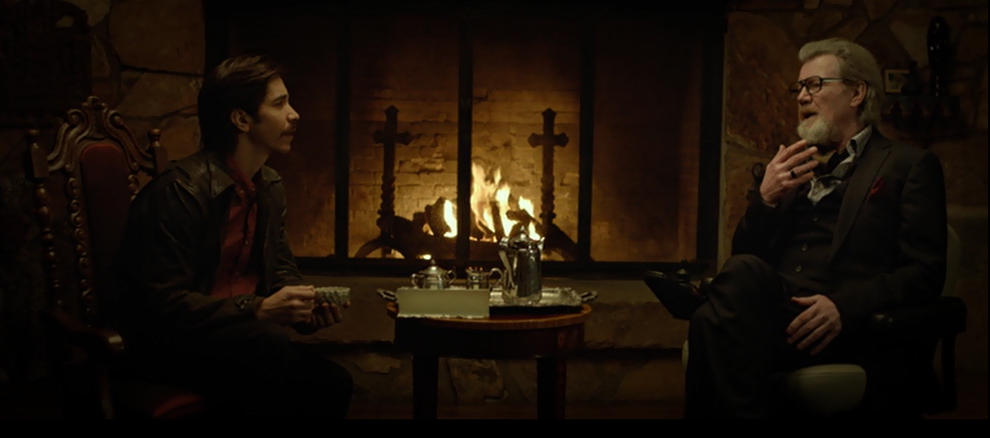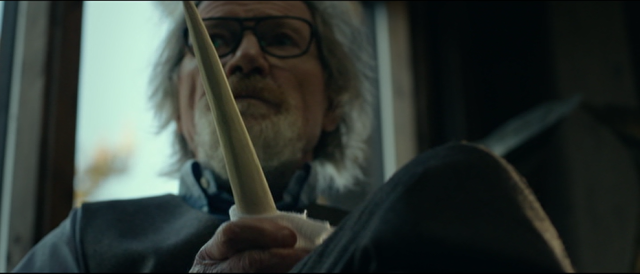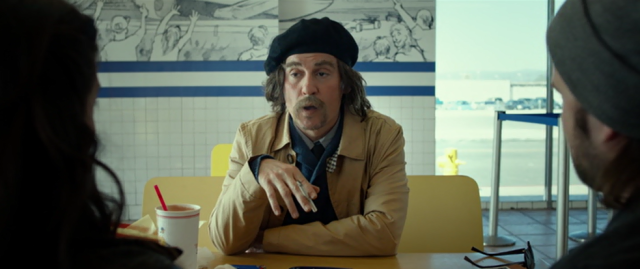Tusk is a monster movie in all sorts of ways, cobbling together tones and plot elements and influences into a creature that demands attention even as it occasionally rips at the seams. Reviewers were quite polarized into adoration and loathing, with a few hearty souls lingering near the middle to say things like ‘the most disturbing movie I’ve seen’ (I must assume these people are young yet, as I laugh and clutch my copy of Naked Lunch and laugh some more). As to myself, I couldn’t help being fascinated with the film as a modern day Portrait of the Artist.
Kevin Smith, for those unawares, has been more or less leading the charge of creator/audience interaction since the internet was young, popping up on message boards for his films to answer questions etc. while other Famous Types stood by shaking their heads (as you can imagine, Twitter was a major ‘told ya so’ moment in fewer words). This open relationship between creator and consumer has had its good and bad effects over the years: on the one hand, few directors can claim the ironclad cult of personality that Smith has; and on the other, that openness has led to more than occasional frustration at announced projects that never came to fruition – after all, for all the openness the internet has enabled, the announcement of an idea from creator to fan is still tantamount to a promise in ways that an idea from creator to friend would not be.
The solution to this, I imagine, is somewhere between ‘creators shouldn’t talk about things unless they’re already almost ready for release’ and ‘fans shouldn’t put stock in a creator’s ideas unless they see proof of concept.’ And it’s not a balance we can ignore – fan interaction with creators is never going to go back to the relative wall of silence it was at before, so the sooner we find a happy place that sidesteps “fans are whiny, entitled dipshits” and “creators are histrionic prima donnas who regard all critique as a personal attack,” the better the world will be. To that end, we come back to the grand experiment that is Tusk.
Before we go on, I would nudge those of you who’re already aware of/inclined toward the film to stop here and go see it. Even with the flaws, it’s a decidedly worthwhile experience that’s heightened by allowing yourself to be surprised. Go for it. Go in blind. Just watch out for Johnny Depp.
For the rest of you, Tusk is a film that began as a conversation between Smith and longtime producer Scott Mosier on their podcast, concerning a want ad about a man offering free lodging in exchange for the lodger agreeing to wear a “realistic walrus suit” for two hours a day (the ad turned out to be a hoax, but it makes a good story anyway). Because it was being recorded, this meant that Smith, always big on sharing his enthusiasm and process, could literally chronicle one of his films from inception to conclusion. A first for many, and there have been all sorts of stories from listeners for whom the experience demystified (and thus diminished the intimidation of) the creative process. That alone is a wonderful thing, and like Jodorowsky’s concepts for an unmade Dune it will no doubt inspire young artists for years to come – with the added bonus of being freely available to the masses. Except Tusk actually got made, which means we have to consider the birthed idea as part of this narrative.
The plot’s pretty straightforward: our protagonist Wallace (a Woody the Woodpecker reference if ever I heard one) cohosts a podcast called the Not-See Party with his friend Teddy, a show which is basically an audio-only Tosh.0. Wallace takes a trip up to Canada only for his intended interview subject to be a bust, but all is not lost: he finds a letter pinned to a bathroom bulletin board (Canadian bars, I guess) from an old man who claims to have decades of seafaring adventures to share. Because he is a smart person with good decision making skills he goes alone to an isolated house without telling anyone to meet this total stranger, who – surprise! – drugs his tea and sets about mutilating Wallace into walrushood for his own demented reasons.
And you know what? For the first hour the movie really, really works. Despite the Human Centipede vibe of the premise, much of the time shared between Howard (Michael Parks, clearly relishing the part that was written as a love letter to his considerable talents) and Wallace feels far more like Misery, particularly in the pre-suit scenes. Those interactions have a sickly veneer of civility, leaving the audience squirming in anticipation of the moment it will inevitably be punctured by violence, and Long holds his own with a spectacularly relatable devolution from insistence into panic. When the time comes for the big suit unveiling, it is every bit as breathtaking as the movie wants (and needs) it to be. Robert Kurtzman’s design a masterwork of creature craftsmanship that crucially holds its ability to unsettle even after prolonged exposure (I am wholeheartedly ready to fork over the cash for the upcoming Yoga Hosers just to see what else he comes up with). Every scene with Long and Parks is spellbinding, tightly paced and acted by actors who can happily run away with the script’s expected balance of poetic monologue and dick jokes, I was happy as a gore-soaked clam.
Alas, there are still the problems to be discussed. The structure of the film gives us prolonged, tense scenes in the house that are broken by little gasps of outside information: usually flashbacks to pre-trip Wallace or an update of his friend and girlfriend searching for him. Early on this works quite well, giving us just enough of a break from the tension to avoid getting desensitized while also filling out Wallace as a character. I’ve a minor complaint in that Wallace’s plight is most visceral and distressing when we know him as a pretty alright guy being terrorized at literal random, and once the flashbacks start revealing that he was kind of a dick it’s easier to reframe his situation as a pseudo-morality play, but it’s not really fair to hold that against the film. Smith’s scripts have always had a deeply personal heart to them, and it’s pretty easy to see Wallace as the director’s personal worst nightmare: a podcaster who’s lost sight of his compassion in the name of selling tickets and getting laughs, who values the pursuit of his own goals over his relationships with his loved ones.
The bigger problem, as nearly every other reviewer I’ve come across has mentioned, is Johnny Depp as PI Guy LaPointe. I don’t really like being in a world where I had to type that, but here we are. It’s not that Depp himself is awful – he’s playing a literal caricature, a stock character lifted from the back-catalogue of Smodcast, and there’s a strong sense that he’s at least trying to balance the character’s written Canada gags and eccentricities with the gravity of the situation. The problem is how his role is nested in the film: this is a character with about a scene’s worth of good jokes and useful information, and the actual amount of screentime he’s given is simply agonizing (you know that scene in Silence of the Lambs where Clarisse is talking to Buffalo Bill and she doesn’t know it’s him yet? Now imagine if it was twice as long with no stakes, on account of being a flashback).
By the time the audience’s goodwill for Guy is spent, wrung, and shaken down for excess cash, the film has entirely lost its sense of urgency. And that is deadly to the film. By the time we get back to what should be the climactic scene between Howard and Wallace we’ve been shaken out of our emotional engagement, and it’s far too easy to sit back and think about how weird this all is rather than tuning into the emotional frequency. It’s not an entire loss, as the early scenes resonate strongly enough to draw you back in about halfway through the climax, but it’s a shadow of what it could’ve, should’ve been. The film peters out instead of exploding the way it was clearly designed to, and we’re too busy being vaguely baffled to be haunted by the logically stupid but visually evocative final scene.
And the problem with Depp is a problem seeded in the film’s very birth, all the way back to that podcast: it’s one big inside joke, an admitted love letter to followers of Smith’s veritable army of podcasts (that’d include me for the most part, just in case that mild bona fide wasn’t clear). For the most part, this manifests as a nearly endless stream of fun but unobtrusive Easter eggs: Hollywood Babble-On co-host Ralph Garmin playing a Canadian Cop, the burger joint as love letter to the “Gimli Glider” story, Wallace’s ringtone, and so on. Even the more obtrusive joke-line “is man truly a walrus at heart,” when given to Parks, has a demented sort of logic to it. But in Depp’s scenes that semi-restrained playfulness bursts out of the movie’s chest and devours it (Smith quite clearly respected the two great actors he’d snagged, which I imagine why the flashback particularly is so interminable).
When the film guts itself on the very pillar that elevated it into existence, right at the finish line, it brings the whole open source thing into question. If the film was conceived and cobbled in that atmosphere of forgiving camaraderie, where are the lines drawn between structure and indulgence? It needs the latter to exist, but the former to last, and as a pretty dedicated fan of the director I’m all the more disappointed for how close Tusk came to pulling it off. Granted, most beginning artists won’t ever face the question in the same way, lacking the reach and coin of 20 years in the film industry, but these are the kind of habits that start early and become terminal without self-reflection. An inspiring tale with a hefty footnote, then, and a nonetheless hopeful eye cast toward the next film – one which I suspect will carry the comedy more naturally than good Mr. Tusk.
Want to share this on Tumblr? There’s a post for that!
Vrai is a queer author and pop culture blogger; they’re a sucker for good body horror, which has nothing to do with the thing in the basement. You can read more essays and find out about their fiction at Fashionable Tinfoil Accessories, support their work via Patreon or PayPal, or remind them of the existence of Tweets.











Published: Sep 7, 2015 01:55 pm